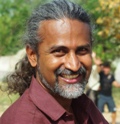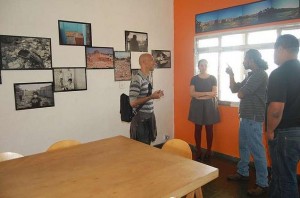Being an Activist and Chasing a Profit: A Contradiction?
Being an Activist and Chasing a Profit: A Contradiction?
Being a successful entrepreneur is, among other things, about making money. The central concern of the VCU.br program was, after all, livelihood. The aim was for the program participants to earn money from making media. As such, talking about wealth – needs, expectations, salaries – was a necessity. Nevertheless, people were reticent to discuss actual figures – NGOs found it distasteful, the participants were embarrassed. It was, however, crucial.

In the following excerpts from an interview with Video Volunteers, Managing Trustee, Stalin K., he discusses the challenges of talking about money in the context of training.
Why were you keen to focus on livelihood in the Brazil project?
There are a huge number of community media projects in Brazil – possibly the highest density of these projects anywhere in the world. It was clear that Brazil did not need another community video project – another outlet for people to express their thoughts and lives. What seemed to be lacking was any work on what happened post-training. Most of the projects in Brazil seem to be short term – they happen over the course of a few months or weeks and equip their participants with wonderful skills. At the end of the project, these skills are not utilized in any lasting way.
With this is mind, we did not want to engage in community media training but rather on the issue of livelihood. This focus complemented our focus on sustainability in community media in India (we are working on a joint research program with the Indian Institute of Management – Ahmedhabad on this issue). We want to figure out ways to enable young people trained in community video to earn income by producing media.
Why do you think the favela residents you trained were reticent to speak about money? They are from weak economic backgrounds and so money is a major concern. Yet they had difficulty talking about it. Why is that?
One problem is that it is very difficult for poor people to compute their cost of living, and so many of them don’t actually know how much money they need or are spending. Let me explain: People who have recently left behind a subsistence, non-monetary economy have a very different idea about the cost of living to those who have lived in a monetized economy for centuries.
The difference is that poorer communities the world over tend to live in large family groups; only as they get richer do they split off into nuclear families. So, when you are working in the favelas of Sao Paolo or the slums of India you will find people living in large joint families. This is not just a question of tradition but a question of economics and how the economy works.
For example, in rural communities, you need lots of hands to harvest crops – families tend to work together. In these kind of extended family arrangements, the number of people that understand costs and finances are very few. The patriarchs and matriarchs of the family decide on how to invest and spend money – they are the only ones that really understand costs. Often we assume that if we give a boy Rs. 10 to go to the shop to buy sugar then that boy knows the cost of sugar. But he does not. He only knows how much Rs. 10 buys him at that point in time. A lot of people work in this ‘now and then’ version of economics.
You were trying to teach the VCU.br Fellows to create film budgets, and work out how much money they would need to charge potential clients for films. Was this difficult?

Yes, very. When we asked our fellows ‘how much money do you need to survive for a month?’ the responses were not simple and immediate. For example, many of them do not pay rent. In these cases the future scenarios had to be imagined and laid out for them – ‘if you did pay rent, how much would it cost?’
Like in many poor communities the cost of living is broadly concerned with food, clothing, shelter and entertainment. In Brazil, the ‘entertainment’ or luxury, or whatever you want to call it, is cell phones and the internet.
All the fellows calculated a certain amount of money for spending on that. The average living cost amongst the ten fellows was about 750 reais (approx $460) per month. What we then did was help them figure out – ‘if you need 750 reais a month how many projects would you need to do in a year?’
We then ran an exercise to work out what investment they would need to make to earn that money. This was something new to them as very few NGOs work in the entrepreneur/business mode. They have never had to consider the cost of cameras and training before – this is normally provided by the NGO. Whereas in the market things operate differently – you pay for your vocational training, you invest in your materials and then you try your best. Once we had the size of the investment figured out we repeated the calculation to work out the number of projects needed. What became clear was that the need versus the required number of projects was doable.
A key learning that came out of this process was an understanding of how alien the notion of ‘costing’ was to the fellows. When we talk about livelihood, cost is a key element. We need to work out the cost and then add to it the amount desired to live – that is your net profit. In brief, what we were trying to do was give the fellows a base understanding of economics and a sense of business acumen.
Did the fellow’s commitment to social issues compromise their ability to make money? If yes, why do you think this was?
This question is a time for some truth-telling and articulating where things went right and wrong. As far as Video Volunteers was concerned, we conceived the project as purely livelihood. Now, having said that, when we sat down to design this project, the assumption was that we would be working with ten young people already proficient in filmmaking (their skills gained from other projects). This was a wrong assumption. Although we did get young people from different video projects they needed further workshops to hone their skills to a level that would enable them to compete in the market. We had not accounted for this.
Interestingly, as Casa Das Caldeiras (CDC) was rolling out this project, they were also seeing VVs other projects online. They got excited by the idea of media for social change. They wanted to include it in the VCU.br program. Also, all the fellows came to us through other NGO projects. Therefore, they were already connected in some way to social movements; to social reality and wanting to change it. One can see that VVs background of activism and working with social movements, CDC’s desire to engage with social issues, and the fellow’s backgrounds, all came together to make socially relevant content the obvious route to take. And finally, all the examples that we were giving during training e.g. “what kind of market can you get?” came from the social paradigm because that is where we at Video Volunteers are from – we have no experience of the advertising industry etc.
A few months into the project CDC were pushing to produce only socially relevant content. Now, there is nothing wrong with that but if you are going to do a livelihood project without compromising socially relevant production that means the number of potential clients is limited. They are not only limited, they also have less money to spend than clients in the commercial sector. It is a tension that needs to be cracked.
That is one part of it. Now, if you ask me, what is the most desirable scenario? It is a chicken and egg kind of thing; what comes first – survival or social consciousness? Can the two be mutually exclusive? From a base level – survival is obviously the prime – after all, dead people cannot be socially active! From this perspective I would say that the projects needs to go down a solely livelihood route. Then, we need to trust the sensibilities and the emotional engagement of these young people to engage in socially relevant work; either as a source of income or alongside their commercial pursuits. A lot of very interesting social activists are not social activists for a profession. Why can’t the VCU.br fellows be like that?
The line that often needs to be drawn is the ethical line. What kind of products and media content will you be willing to generate or not as the case may be? I do not want to get into drawing those lines but as a trainer it is important to point out that those lines do exist and that we all need to be conscious of them. Finally, from a tactical point of view, ‘socially relevant media’ is more appealing to funders than ‘entrepreneurship’ and ‘livelihood’.
For Video Volunteers, it is very important that anyone we train can earn a living from making films and will keep doing this work for years to come. It is important for this kind of training to have more than just a short-term impact; be more than just personal empowerment.
NGOs which are involved in media training need to make longer term commitments to the bright young people they work with – short term programs are fine but it is important to have the capacity to engage with participants on a longer term basis and in turn, deepen impact.
We feel that VCU.br is a training program that can be replicated in lots of different media programs. In order for this to be successful, non-profits first need to overcome the hurdle of combining activism and money.

